
MAY CONTAIN NUTS

Search Shorpy
SHORPY ART

Framed or unframed, desk size to sofa size, printed by us in Arizona and Alabama since 2007. Explore now.
Join and Share
Ad-Free Shorpy
Shorpy is funded by you. Patreon contributors get an ad-free experience.
Learn more.

Recent comments
- Those standpipes
- Wrenches
- International D-40 I believe
- Job prospects
- You had me at Train
- Land of the free
- Broad-Exchange Bldg
- Parking innovation
- The old block
- "Peck turned a sweet propeller"
- National Bank Building
- Notch shot
- Straight ahead (right, left, left, right)
- Ship lifespans
- New service
- You Say Station, I Say Potato ...
- Iron Age
- Thank you, Cornelius Vanderbilt
- Grand Central Terminal
- If they made a movie of it
- Obsolete by then.
- Half the tonnage at the NYPANO dock
- Ravages escaped, bank notes signed and dated
- Chatham expansion
- Steepled in History
- Made by York
- No Summer Vacation
- Wait a minute ...
- $$$
- Joad on the Road
Member Photos
The Shorpy
Printporium
Printporium
Search Shorpy
Search results -- 30 results per page
- Caprine Caper: 1904
- ... not the heat ... it's the stupidity. Or so they say in New Orleans. In this case, I'm betting it was a hot, humid day. The squinty ... Posted by Dave - 12/08/2022 - 10:44am -
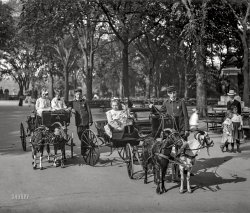
- Generation Gap: 1937
- New Orleans circa 1937. "Courtyard at 1133-1135 Chartres Street." Young and ... House Hotel.
It still amazes me how the homes of New Orleans have survived.
As a photographer I really As a photographer ... Stanley: Stella!!
(The Gallery, F.B. Johnston, Kids, New Orleans) ... Posted by Dave - 08/03/2012 - 4:08pm -
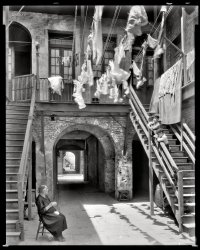
- New Denechaud: 1908
- New Orleans circa 1908. "New Hotel Denechaud, Poydras Street." A century later, ... hotel with proper French diction.
Creole, not Cajun New Orleans is not a "cajun" city. It is creole at best, and if anything most ... view of the lobby reads "$1,000,000.00 Hotel DE SOTO New Orleans. The ONLY ABSOLUTELY FIREPROOF HOTEL IN NEW ORLEANS. ALL OUTSIDE ... Posted by Dave - 08/05/2012 - 4:24pm -
![New Denechaud: 1908 New Orleans circa 1908. "New Hotel Denechaud, Poydras Street." A century later, it's the hotel Le Pavillon. Detroit Publishing glass negative. View full size.
Le PavillonMy wife and I stayed there several years ago, and we had dinner there just a few weeks ago. The dining room is on the ground floor in the corner nearest the camera.
It's a very nice hotel with a unique touch. Every night at 11, they serve to the guests peanut butter sandwiches on silver trays, and hot chocolate from silver urns.
But the people who work there apparently can't pronounce the name of the hotel with proper French diction.
Creole, not CajunNew Orleans is not a "cajun" city. It is creole at best, and if anything most street names aren't pronounced correctly either.
French diction?This isn't Paris -- it's Nawlins!
CoverageAre those sea shells on the roof in the foreground? I believe most modern roofs use stones. Interesting.
Very beautiful building! I can imagine how impressive it was at the time!
Roof GardenIs that a little ivy garden boxes on the roof of the building in the corner? Sure looks it!
[Horticulture a la Morticia Addams. - Dave]
LouisianaWe dont speak French here. We speak Cajun, a 200 year old corruption of French, so don't expect proper French pronunciation.
Early Sunday morningGiven the long shadows for the low sun and the orientation of Carroll Street, and the absence of anyone except the lone blurred horse and cart (deliveries), sure looks like an early Sunday shot to me. Real nice photo too!
[Also note the shadowy figure in the alleyway. - Dave]
Denechaud / DeSoto / Le PavillonIn between its opening as the Denechaud and the current name of Le Pavillon, for generations the hotel was known as the DeSoto. I recall when the question of correct pronunciation of "Le Pavillon" came up, a local old timer piped in "De Soda."
The text on the back of the attached early 20th century postcard view of the lobby reads "$1,000,000.00 Hotel DE SOTO New Orleans. The ONLY ABSOLUTELY FIREPROOF HOTEL IN NEW ORLEANS. ALL OUTSIDE ROOMS. Famous for its Creole Cuisine. Rates $1.00 and Upwards."
The lobby is still one of the most beautiful in the city. I believe the rates have gone up.
Lots of charmLovely building! The chimney is blowing off quite some smoke - must have been a windy day!? Le Pavillon still looks charming today and, I just found out, seems to be famous for the occasional ghost apparition.
Max Barnett Furniture Co.Max Barnett Furniture Co. can be seen in the background. It was established there on Poydras St. in 1899, and was located there until they moved in 1928.
Smokestacks still thereThe two smokestacks are coal burning stacks, which were used for producing electricity until 1973. They are located in the 1200 block of South Peters Street. Maybe someone else can help identify the other tower, as it was prominent in the New Orleans skyline until a few years ago.
Yes, shells on roofThere are no stones in south Louisiana. Mollusk shells dredged from brackish Lake Pontchartrain were used as gravel throughout the area until quite recently. Dredging in the Lake was banned in 1990 to reduce the turbidity and stirred-up pollution. The lake is now clean enough for swimming much of the time. I've also seen oyster shells used for gravel in NOLA.
(The Gallery, DPC, New Orleans)](https://www.shorpy.com/files/images/4a23119a.thumbnail.jpg)
- Royal Furniture: 1937
- New Orleans circa 1937. "842 Royal Street, Sign." Among the highlights: ... wouldn't you love to get your hands on some of that 1937 New Orleans bric-a-brac? Most shops like this today have had their inventories ... than straight coffee.
(The Gallery, F.B. Johnston, New Orleans, Stores & Markets) ... Posted by Dave - 07/19/2012 - 4:37pm -
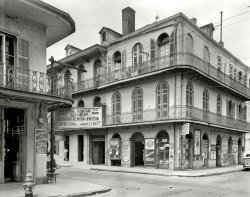
- Esplanade Avenue: 1900
- "Esplanade Street, New Orleans, 1900." And running along the grassy median, streetcar tracks. ... is grass, not pavement. The old-timers call these New Orleans medians "neutral ground." Which sounds electrical but isn't.
... calls the area in the middle of a divided New Orleans thoroughfare its neutral ground. Just the way it is.
(The ... Posted by Dave - 08/14/2012 - 3:59pm -
![Esplanade Avenue: 1900 "Esplanade Street, New Orleans, 1900." And running along the grassy median, streetcar tracks. Detroit Publishing Company glass negative. View full size.
Tree TrunksAh, those whitewashed tree trunks. Theories abound as to the reasons for painting. Visibility at night? Insect control? Perhaps just fashion. I remember seeing many in my childhood, few today. I always liked them.
Grandpa said...My grandpa painted all the trees in his Ozark yard about head-high with lime to keep bugs from eating into the trunks. When I asked why the bugs don't just climb up above the white paint, he said, "I dunno 'bout that, boy." My hunch is he was just slapping on the bug paint because that was what everyone else did. The trees seemed to be doing fine without the paint when I toured past the old place decades later.
Rolling alawnAs the caption notes, the dark surface in the foreground is grass, not pavement. The old-timers call these New Orleans medians "neutral ground." Which sounds electrical but isn't.
Esplanade at BurgundyLooking north.
View Larger Map
The "white" on the tree trunksBack when rural driving was the thing to do on Sunday afternoon, I remember seeing this quite often.
Against the normIn a delightful departure from the usual norm on Shorpy, almost all of the buildings in this photo still stand today!
What IS that?Is that a bumper sticker on the utility pole at right center? Can't be.
[It's a pole sticker. Advertising PARKER'S ELVIRA (?) CORDIAL. - Dave]
Let's VogueThose gents are striking some magnificent poses.
Grassy mediansThese days the grassy medians are used as jogging tracks by the Tulane students. Safest place to jog as you can get on a median and jog towards the oncoming street cars w/out worrying about something sneaking behind you. Of course with the old style cars like the one in the photo, the grinding of the gears and popping of the electrical contactors under the cars would give plenty of warning. At night there would be bright green flashes whenever a relay opened its copper contacts.
You can look straight up as you go around Lee Circle and it looks like the monument is slowly rotating.
No streetcar named "Desire" anymore, but there is a Desire bus line. "Bus named Desire" just don't sound right, do it?
Lawn trackVery interesting that lawn track is such an old invention! It's been introduced in a number of places recently to reduce noise and have a prettier city environment, but I wouldn't have thought that the idea is that old.
Neutral GroundNot just old-timers—everybody calls the area in the middle of a divided New Orleans thoroughfare its neutral ground. Just the way it is.
(The Gallery, DPC, New Orleans, Streetcars)](https://www.shorpy.com/files/images/4a05035a.thumbnail.jpg)
- Stuyvesant Dock Terminal: 1900
- ... circa 1900. "Stuyvesant elevators, docks, R.R. terminal at New Orleans." Detroit Publishing Company glass negative. View full size.
... opening of the terminal was a great leap forward for the New Orleans and Louisiana economies, and it was dedicated with "imposing ... Posted by Dave - 08/14/2012 - 4:01pm -
![Stuyvesant Dock Terminal: 1900 Louisiana circa 1900. "Stuyvesant elevators, docks, R.R. terminal at New Orleans." Detroit Publishing Company glass negative. View full size.
Harrison Line, LiverpoolAccording to a German/Weimar Cigarette card book "Lloyd Reederei-Flaggen der Welt-Handelsflotte" published by the Martin Brinkmann AG Zigarettenfabrik circa 1933, the flag represents the Harrison Line, Liverpool (Charente Steamship Co., Ltd.)
The flag is a red Maltese cross on a white background.
Working in:
England to the West Indies, Gulf ports and Mexico, Brazil, and Africa
Operating:
42 Cargo boats with small cabins
2 Passenger Freighters
Total Tonnage:
239,720
Honoring Mr. FishThe Stuyvesant Dock Terminal was named for Stuyvesant Fish (1851-1923), President of the Illinois Central Railroad, presumably because not even he was happy with the idea of calling it the Fish Dock Terminal. The opening of the terminal was a great leap forward for the New Orleans and Louisiana economies, and it was dedicated with "imposing ceremonies" conducted by Governor Murphy J. Foster and Mayor Walter C. Flower, on November 4, 1896, and with remarks by Mr. Fish on behalf of the railroad company.
According to the New York Times (10-26-1896), "The construction of these docks is the beginning of a great effort that the railroad will make to bring European shipments via [New Orleans] for Chicago, St. Louis, Cincinnati and all Western cities. The wharfage will be absolutely free to all steamers landing at the docks with interior freight for shipment by the Illinois Central Railroad, and such a saving in port charges, it is believed, will bring a great body of traffic this way."
Pristine tracks and locomotiveWhat really stands out to me in this photograph is the pristine condition of the yard tracks and the 0-6-0 that is hard at work. In 1900, stub switches were still in vogue in the South and West, as was unballasted track. The frog switches show that the Illinois Central was dedicated to being a truly modern railroad, as willc's research shows. I'm fascinated by the shiny boiler jacket and controls in the locomotive's cab, I suppose the same crew ran this locomotive daily or the engine terminal really spent some time on cleaning every night. I can assure that my local Canadian National/Illinois Central yard is being switched by a diesel that is no where as clean as this little teakettle!
And in 1905Disaster strikes.
History repeatingThe Stuyvesant Docks were on the Mississippi between Louisiana and Napoleon Avenues, stretching for twelve blocks before they burned in 1905. If you google that area today, you can still see the footprint of the massive railyard and the skeletal remains of the docks which burned again just a few years ago.
Backward CompatibillityThe slot and hole in the knuckle of the switcher's coupler are there to accommodate a link and pin, if a car with the just recently obsoleted (and dangerous) link and pin coupler needs to be moved. You can still see these coupler modifications on a few museum engines.
Dead or AliveThere isn't a man dead or alive who wouldn't jump up and sit on that tender next to the sign "Keep Off" because that's the way we are wired. Gotta love us…
Where in the world?Can anyone identify the flag atop the ship mast? It looks like a Maltese cross, but a quick search turned up no such flag.
Shipping Company House FlagsMost commercial shipping companies had house flags that were flown from the highest mast, at least in port. There were hundreds of designs, only a portion of which were recorded in registers. I didn't find a plausible match online for the flag seen here, but found several similar designs in the 1912 edition of "Lloyd's Book of House Flags and Funnels," a sample from which is seen here to illustrate the idea.
Colorized versionI colorized a major portion of this photo. Please look here and list any comments you may have. Thanks..
(The Gallery, DPC, New Orleans, Railroads)](https://www.shorpy.com/files/images/4a05057a.thumbnail.jpg)
- The Quarter: 1903
- New Orleans circa 1903. "Old French courtyard." Shabby chic alfresco. 8x10 inch ... what type of bottle the cap was from. The courtyards of New Orleans are mysterious, and sometimes seem spiritual, mystical, even ...
Weathered Wow, even over 100 years ago this New Orleans courtyard looked like it had been ravaged by Hurricane Katrina. ... Posted by Dave - 08/21/2012 - 10:50am -
![The Quarter: 1903 New Orleans circa 1903. "Old French courtyard." Shabby chic alfresco. 8x10 inch dry plate glass negative, Detroit Publishing Company. View full size.
Tennesseechoked on an eyedropper-type cap. He was holding the cap in his mouth as he applied the drops.
What on Earth?Not really sure I want to see the front of that infant lefty quarterback with the demonic scaly tail.
Thomas Lanier WilliamsBetter known as Tennessee, would have adored this once-majestic but now decrepit garden and these crumbling buildings as a stage set for his unforgettable, prolific plays, although he wasn't born until 1911.
Ironically, with all his poignant and deeply emotional Southern-flavored stories, his own unexpected end came when he choked to death on a bottle cap in a New York hotel on February 24, 1983, a month before his 72nd birthday. Then again, he probably could have written such an ending for himself, depending on what type of bottle the cap was from. The courtyards of New Orleans are mysterious, and sometimes seem spiritual, mystical, even supernatural. These are the backyards of the Stanley Kowalskis.
Stanley was the real name of his boss in a shoe factory. Personally, I'm partial to the broken bench. What else do you wanna know?
Better than tossing out the windowThose drain pipes by the window seem like a practical solution to a vexing problem. Kind of gross, but better than most alternatives.
WeatheredWow, even over 100 years ago this New Orleans courtyard looked like it had been ravaged by Hurricane Katrina.
WeatherproofingDon't go by the plaster and paint. The plants and walkways are neat and well-tended, the wooden railings aren't broken and shaky, and the glass windows are all intact, with straight, uncracked frames.
We tend to forget the enormous advances that have been made. The climate of New Orleans is extremely destructive to the paints available in that era, and to stucco over brick and unreinforced concrete like the plant borders. The front of this house is probably neatly kempt, even by modern standards, but here in a private space they didn't feel the need to expend the large sums necessary to renew the big plastered wall(s). A view of the same or a similar courtyard today might not look all that different except that the brickwork would be painted, an option not available in 1903 because the available paints wouldn't stick to it.
Water towerslooks like a couple of wooden water towers to the right. Anyone know anything about that?
[The cisterns hold rainwater. - Dave]
RamshackleWhat's curious to me is how that short double level balcony on the left has no supports to it underneath. Seems it wouldn't take too many people at one time on both levels to send them spilling into the garden?! Hope it's been shored up in the intervening 108 years!
Court of the Two SistersI think this might be what is now the "Court of the Two Sisters." The balconies have no supports then or now, as is quite common. The steep pitch shoots the water away from the structure. It was common to have two or three cisterns for a residence up until 1905 when they were outlawed because of concerns over yellow fever. The fountain in the courtyard could have been "run" by one of the cisterns.
[Or: Court of the Two Cisterns. - Dave]
(The Gallery, DPC, New Orleans)](https://www.shorpy.com/files/images/4a10812a.thumbnail.jpg)
- Payday on the Levee: 1906
- New Orleans circa 1906. "Payday on the levee." Don't spend it all in one place. ...
Union Station, NOLA This would be Union Station in New Orleans that serviced the Southern Pacific railway (opened on June 1, ... it was demolished in 1954 and replaced by the current New Orleans Union Passenger Terminal.
Payday II An alternate version. ... Posted by Dave - 08/21/2012 - 10:50am -
![Payday on the Levee: 1906 New Orleans circa 1906. "Payday on the levee." Don't spend it all in one place. 8x10 inch dry plate glass negative, Detroit Publishing Company. View full size.
Why wait.Didn't these guys ever hear of direct deposit?
No Cutting in That LineCurious why the people in line feel the need to hang onto each other.
[It might have something to do with the photographer, and the size of this photograph. - Dave]
PaydayI would guess that a substantial portion of the funds disbursed here will be divided between dice and the bottle, that counts as more than one place.
That's an eager looking line.
Union Station, NOLAThis would be Union Station in New Orleans that serviced the Southern Pacific railway (opened on June 1, 1892). it was demolished in 1954 and replaced by the current New Orleans Union Passenger Terminal.
Payday IIAn alternate version. The nun has moved! Also note little girl. Click to enlarge.
Something for the palate Lee & Perrins? Makers of the Worcestershire Sauce I use on my steaks? Interesting and tasty too!
Close QuartersObviously these men waiting to get paid have no fear of pickpockets, since they are probably penniless temporarily.
Dirty Dancing and the nun's rulerAnyone who has ever been to a teen dance at a parochial school in the 50's will remember that dancing partners had to dance far enough apart for the chaperone/nun to fit a 12-inch ruler between the couples' chests, lest anyone get evil thoughts. The nun in this photo does not seem concerned about that even though this line of anxious money recipients would be considered dirty dancing or 'grinding' which is totally forbidden at most school dances today. I'm puzzled by the nun in this picture but this is another stellar example from Shorpy of the inspiration their photos provide for fiction writers. Thanks Dave for this great picture. I'm lovin' it.
Being GreenI take it they recycle their rainwater?
[Cisterns were big back then. - Dave]
PrioritiesThey'll probably spend a large portion of their pay on whiskey and women, and waste the rest.
StymieWaits patiently by the Worcestershire.
(The Gallery, DPC, New Orleans, Railroads)](https://www.shorpy.com/files/images/4a10819a.thumbnail.jpg)
- Levee Work: 1903
- New Orleans, Louisiana, circa 1903. "Mule teams on the levee." 8x10 inch dry ... in the background.
Thanks for showing us a long-gone New Orleans.
The railroads are the Alabama & Vicksburg, which ran ... was a freight car provider.
(The Gallery, DPC, Horses, New Orleans, Railroads) ... Posted by Dave - 07/19/2012 - 4:35pm -
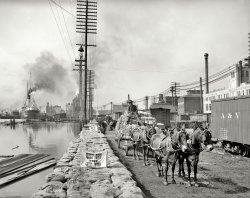
- Bicycles, Cadillacs: 1910
- New Orleans circa 1910. A close-up of the H.A. Testard Bicycles & ...
(The Gallery, Cars, Trucks, Buses, DPC, Motorcycles, New Orleans) ... Posted by Dave - 04/06/2013 - 11:58am -
![Bicycles, Cadillacs: 1910 New Orleans circa 1910. A close-up of the H.A. Testard Bicycles & Automobiles storefront from the previous post. Detroit Publishing Co. View full size.
And Motorcycles Too!Sure is a motorcycle prominent at the end of the window. I can't
tell what make it is (there were a lot). But, back in those days
motorcycles had more in common with pedal bicycles than not.
What a lovely old car!And it's under repair - the far side of the bonnet (or hood, as it's American) is open. I can't make out a manufacturer's name on the front: does anyone know what kind it is?
[It's a Cadillac. - Dave]
Move along, nothing to see here...Unless you want your SOUL to be EATEN!
Still around.There are some of those cars around today thanks to collectors.It would be great if this car was one of them.
French ConnectionCouldn't help but notice the similarities with this bike shop, still functioning in Montreal.
View Larger Map
Bugs in Your TeethHere's the Cadillac, with optional no windshield, snapped at Hershey, Pennsylvania, October 2009
General Store? Ah yes, autos, bikes and... funnels? I guess fueling up could be quite the adventure in those days.
1910 Indian singleAs far as I can make out the motorcycle is a Indian 1910 single. A current photo of one can be seen in
Classic American Motorcycles by Tod Rafferty. According to the book they sold that year for $215.
(The Gallery, Cars, Trucks, Buses, DPC, Motorcycles, New Orleans)](https://www.shorpy.com/files/images/4a19856a1.thumbnail.jpg)
- Madame Boyle's: 1901
- ... is the Louisville & Nashville's line from Mobile to New Orleans.
View Larger Map
Live Oaks Live On Despite ... Posted by Dave - 08/13/2013 - 3:48pm -
![Madame Boyle's: 1901 Bay St. Louis, Mississippi, circa 1901. "Shoo-fly at Madame Boyle's." Another glimpse of nattily dressed tourists taking the air in this Southern resort. 8x10 inch dry plate glass negative, Detroit Publishing Company. View full size.
All God's Children got hats....I can count only the lady of the house and her son plus the dog and the horse who do not have their heads covered with a hat. The boy has bows on his shoes and a tuxedo- like jacket. These certainly were some formal looking summer clothes considering the sultry heat and humidity of the Mississippi coast. I really did feel like I was in the deep south when I summered there a few times enjoying evening cruises on old-time riverboats and I absolutely loved the people, its a whole different world. Nice photos, thanks Shorpy.
[I think it's probably winter or spring. Not much resort business down South in the summer. - Dave]
Harry's or Madame Boyle'sThis looks like the view from Harry's Villa - even the same rather ample cheery lady and her husky little boy. So does the place belong to Harry or Madame Boyle? Or does the platform below to Madame?
Love it any which way!
[It is the same place, obviously. And the lady is wearing the same dress in each photo. - Dave]
The other side of the fenceThe two little boys pausing across the street to take a look at all the swells having their photo taken makes this a classic. (And do you think Mr. Fedora may be overly attached to that potted plant?)
Pass the smellin' saltsOne thing I've noticed in my short time here is how easily some are overcome by the vapors when confronted with manly specimens.
Interesting that they didn't bother to whitewash the inside of the picket fence.
That little kid was born 20 years too early, or he'd have been a star in the Our Gang shorts.
Young Will RogersThat's gotta be him -- second from right sitting on the tree deck.
Well HelloDoes anyone have a time machine I can borrow? I'd like to spend some time with that lad at the bottom of the stairs with his leg thrown over the railing. *sigh*
Wow!Little windy in this photo. I just love everything going on in here. The dog, the horse, that guy on the bike, those two little kids in the background (especially the grin on that one little guy). Not to mention the one legged ghost by the sailboats. Might I ask why it looks like they whitewashed the trees half way up? To better match the fence?
Odds and EndsOne thing I've noticed in my long time here at Shorpy is that amorous comments posted about women in these photographs outnumber those posted about men by at least 15 to 1. Overcome by the vapors? Aargh!
WhiteoutSo why are the tree trunks and utility poles painted white?
Notable IndividualIn photographs like this, I am as interested in the long gone tree specimens as I am in the human ones. Unfortunately I am left to guessing tree species most of the time. The one here is as notable as the people. Can anyone identify it -- or even better, its history?
[Looks like a live oak. Or maybe a water oak. - Dave]
Too poor to paint, to proud to whitewashIn Northern states, the trunks of trees are whitewashed to help prevent winter sun scald. In the south, lime-wash was used for insect control. It was believed that it would keep catepillars from climbing and borers from boring. And besides, it's makes everything look so pretty!
The view todayThe bridge is the Louisville & Nashville's line from Mobile to New Orleans.
View Larger Map
Live Oaks Live OnDespite Camille, Katrina, and probably a half dozen more hurricanes that have hit the Bay St. Louis area since that photo was taken, that old live oak is probably still there and doing well. Everything else in the photo, well they are surely long gone.
If the rose thorns don't get you...This looks to be somewhere along North Beach Boulevard, given the bridge in the background, and the Gulf beyond. There are still a few old houses along there.
The tree appears to be a live oak, Quercus virginiana -- we have two in our yard that look like descendants of this specimen.
With respect to the whitewash on trees and poles: growing up in the deep South, I was also given the explanation that a bit of whitewash might prevent an unfortunate collision in which I might be the injured party. Note the tips of the stakes for the roses.
What Caught My EyeThe year was 1901 and the majestic live oak must have been so old when the pic was taken. Live oaks grow very slowly. It lived a long life even before this picture was snapped...I'm awestruck.
Gone With the WindI hate to say it, but if this tree was still there after Camille, it was surely taken out by Katrina. Bay St. Louis was virtually wiped out. We went thru there four months afterward and it was simply a clean slate. Nothing was standing. I was always told the white paint was to keep bugs off the trees. We had a river house and we always had to put screening on all our trees to keep the beavers from chewing them to pieces.
Snowbirds on the Gulf CoastI grew up in Pass Christian, across the bay from Bay St. Louis, as did my mother, who was 20 at the time of this photo, sewing dresses like these for the "snowbirds" who came down from Canada to spend the winter at the Mexican Gulf Hotel across the street from her family home.
I have pictures of some of them and also some of my mother and father in their "courting" clothes on the beach at P.C. I think that that photo is close to, or across the street from St. Stanislaus Hi School, which survived both Hurricanes. Many of the old homes on East Beach Scenic Drive in P.C. survived Katrina while the West Beach side was devastated.
(The Gallery, Bicycles, DPC, Travel & Vacation)](https://www.shorpy.com/files/images/4a08954a.thumbnail.jpg)
- Madame F: 1922
- ... of E.J. Bellocq,who documented the ladies of Storyville, New Orleans at the turn of the century. Not that I'm making any assumptions ... Posted by Dave - 07/27/2012 - 12:21pm -
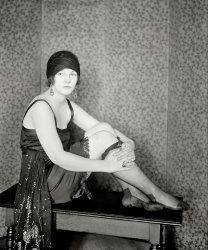
- Fox the Hatter: 1910
- New Orleans circa 1910. "St. Charles Avenue from Canal Street." 8x10 inch dry ... in Tulane's special collections.
(The Gallery, DPC, New Orleans, Stores & Markets, Streetcars) ... Posted by Dave - 08/14/2012 - 3:48pm -
![Fox the Hatter: 1910 New Orleans circa 1910. "St. Charles Avenue from Canal Street." 8x10 inch dry plate glass negative, Detroit Publishing Company. View full size.
Nattiest & Newest
1899 Advertisement
Fox, The Hatter,
All the Nattiest, Newest, Best Made Headgear on the Market.
Fashionable and Up-To-Date Styles.
Umbrellas and Walking Canes, A Specialty.
Frank Fox, the Hatter.
I don't know FoxBut I've purchased several hats at Meyer the Hatter, 120 St. Charles. They've been around since 1894.
What, no dentist?This may be the first business district shot I've seen on Shorpy that didn't have a dentist's sign in it. Hard to find a good dentist when you need one.
And nowKolb's is still there although the sign has been updated. Looks like there is still a restaurant where Fabacher's was. Interestingly, the street looks narrower now than it did in the 1910 picture but there's still a streetcar in the modern shot.
+98Below is the same view from September of 2008.
Look Behind You!Turn 180 degrees and you'd see the scene posted here 5/6/2010 and find out more about Peter Fabacher, Jax Beer, and other pearls of wisdom.
Get your shoes shined !!!I love the street side shoe shine chair on the right side before the intersection.
Business enduranceGreat to see that German restaurant Kolb is still in the same building in 2008, although now called Kolbs.
More about Kolbs, now in its 111th year:
http://old-new-orleans.com/NO_Kolbs.html
[The restaurant is long gone. See above. - Dave]
Meyer, Kolb, and DeDroitI still go to Meyer to get my hats. Alas, while the sign for Kolb's German Restaurant was preserved, the restaurant is long gone. The last time I ate there about 1993 the interior still looked almost exactly like the below early 20th century postcard. One interesting aspect of the decor was the system of ceiling fans, which Mr. Kolb had acquired from the 1884 World Fair. I wonder what happened to those fans?
Back in the '20s Johnny DeDroit led the house jazz band at Kolb's. DeDroit made a few recordings for Okeh in '24 and '25. In his old age DeDroit said he thought the records turned out lousy, but they sound good to me.
A big fanKolb's was a restaurant that closed sometime shortly after 1992. It featured an amazing ceiling fan system where eight or so fans were all linked by belts and driven (slowly) by one central motor.
Pokorny Shoe StoreI'm new to this site and just saw this photo. Two businesses shown across from Fox the Hatter are M. Pokorny & Sons, which had their mens shoe store in that location for a century before it was destroyed by fire in 1984. Next door to Pokorny's is the Stafford Hat store, owned by Mose Levey (who married one of the Pokorny daughters). The Pokorny family also had a real estate investment company and at the company's height in the 1920s owned about a third of the properties on St. Charles Ave. between Canal and Poydras, including the Liberty Theater (another photo on this site) and the property where Whitney Bank is today. The full list of properties is with the Pokorny papers archived in Tulane's special collections.
(The Gallery, DPC, New Orleans, Stores & Markets, Streetcars)](https://www.shorpy.com/files/images/4a23678a.thumbnail.jpg)
- Old French Market: 1890s
- Circa 1890s. "The old French Market, New Orleans." Points of interest include many horsecars and an arc lamp on a ... Palermo, with the recent immigration of Sicilians to New Orleans. There was a turf war between the Provenzano and Matranga gangs, ... coffee stands.
The Picayune's Guide to New Orleans, 1900
French Market.
You know it by the busy rush, ... Posted by Dave - 04/28/2013 - 12:41pm -
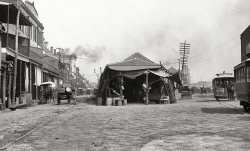
- Harry's Villa: 1901
- ... Coast a lot of these houses were owned by families from New Orleans who stayed there in the summer to escape the worst of the heat and ... go stay there in the summer. My grandfather would stay in New Orleans, and come out to Gulfport on the weekends, taking the train that ... Posted by Dave - 08/13/2013 - 3:45pm -
![Harry's Villa: 1901 Mississippi circa 1901. "Harry's Villa, Bay St. Louis." 8x10 inch dry plate glass negative, Detroit Publishing Company. View full size.
Simply grandI love this photo. How wonderful. I have never seen a picture of such a well dressed crowd looking so casual. If you could step back in time and just land here, it wouldn't be so bad to hang around for a day.
"Buster Brown"I expect Buster's name was either Beauregard or Leroy!
TextureSuch an interesting shot. I love all the texture from the tree, roof, and dirt. The people are interesting too. Like the little boy on the railing and the zonked out guy in the hammock.
Carbide lampThe bike "horn" that one person noted is a headlight powered by carbide pellets and water mixed to create a gas and then lit (like early mining lamps). Very cool photo that is now my desktop wallpaper. Love it!
A beautiful and lost timeMost of Bay St. Louis appears to have been swept away by Katrina. Almost all of the beachfront lots are still empty, with nothing but slabs, or front steps leading to houses that no longer exist.
Shady Rest"There's Uncle Joe, he's a movin' kinda slow, on the hammock."
I Wonderhow many more years went by before that tree crushed Harry's Villa?
Arboreal TemptationI'm sure any of Harry's younger guests would have been tempted immediately by that tree. Good ole Harry even provided a platform to make it up to the first level. I wonder how many took on the challenge before the yelling and running around got started.
Hanging outEveryone looks so front-and-center for their photo op, except for the fellow in the hammock, who couldn't be bothered.
I'm just wild about Harryand his villa, but can't find any info on it. Another copy of this picture is located on the Hancock County MSGenWeb site, but sans remarks. It is quite a nice little 19c Greek cottage, and I love the tree "house."
The good old daysI love the bicycles, especially the one leaning under the platform surrounding the beautiful tree. Check out the horn!
[As noted above, that's a headlamp. - Dave]
Takes my breath away.This image is just plain fantastic. From the vintage bicycles to the fantastic clothing modeled by some easy going town folk. An instant in time captured that seems like so long ago, but looks like it was taken only yesterday.
That tree stand must be for watching the Fourth of July parade.
BTW, is that Buster Brown standing on the railing???
Amazing photo!The house looks like a facsimile of the Jefferson Davis House - Beauvoir - over in Biloxi about 30 miles away. The seating area around the tree is called a "Shoo-Fly" - it was built up off the ground so that in the evening people could sit (and smooch?) above the ground and avoid the low flying mosquitoes, gnats, and flies that are fairly pervasive during the warm summer months.
Wonderful placeBay St. Louis, Biloxi, Gulport, Waveland - all along the Mississippi Gulf Coast a lot of these houses were owned by families from New Orleans who stayed there in the summer to escape the worst of the heat and humidity in the city - at least you had the breezes off the Gulf. My father's parents had a house in Gulfport on the beach, and Dad talked about how my grandmother, his sisters and he would go stay there in the summer. My grandfather would stay in New Orleans, and come out to Gulfport on the weekends, taking the train that used to run regularly from N.O. along the towns on the Gulf. This was back in the 1940's. People had been vacationing there since the 19th century.
When I was a kid in the 1970's my parents and I would sometimes stay on the weekends at a house in Bay St. Louis which was owned by cousins of very good family friends of ours, when it was loaned to them. The house had originally been built in the 1880's. It was a big Queen Anne house, originally a third of an even more enourmous house. During some earlier hurricane, the center of the house was heavily damaged, so the center was torn down, and two houses made out of the left and right portions. Considering the remaining houses were not THAT close to each other, and were both sizeable themselves, the original must have been truly gigantic. I remember 12'-14' ceilings, floor to ceiling windows, wallpaper that must have been from the 30's, no AC, huge screened porches with swings, thinking back on it now.
The house was sold 30 years ago, and completely renovated by the new owners-I passed by it about 10 years ago. It was destroyed in Katrina, as were all the places around it.
WealthAnother thing that I haven't seen commented on (yet) is that this family is probably very well off financially. The title itself loosely implies this is a home away from home. Also everyone has shoes on (odd for this time period for younger children). And that kid on the railing is quite plump. All these little things add up to... Harry's done well for himself.
It's just an observation... nothing else should be taken from it.
[This is most likely a boardinghouse for vacationers. - Dave]
Note the Spanish MossNote the Spanish Moss hanging on the tree in the upper left of this photo; this is a good representative example for those of y'all not familiar with it.
Well before Katrina, Camille devastated this area in 1969. Until then, US Highway 90 between Pascagoula and Bay St Louis was one of the prettiest scenic drives in US, with old large houses, many antebellum, white fences, and large oaks with spanish moss on one side, and white sandy beaches on the other side.
---
Just a hop, skip, and jump along the coast east of Bay St Louis:
https://www.shorpy.com/node/6834
https://www.shorpy.com/node/6834
https://www.shorpy.com/node/6230
https://www.shorpy.com/node/5717
https://www.shorpy.com/node/4617
https://www.shorpy.com/node/3699
https://www.shorpy.com/node/3698
https://www.shorpy.com/node/733
No PeekingIs that a modesty panel inside the railing around the Shoo-Fly? I should imagine that a glimpse of an ankle or (heaven forbid) a leg would be quite unseemly during this time period. Wouldn't want anyone at sidewalk level to see anything they shouldn't.
(The Gallery, Bicycles, DPC, Travel & Vacation)](https://www.shorpy.com/files/images/4a08953a.thumbnail.jpg)
- Mammoth Oak: 1900
- ...
The International, July 1900.
From Mobile to New Orleans
… Pass Christian, the next stop, is considered by ... Posted by Dave - 08/22/2012 - 9:24am -
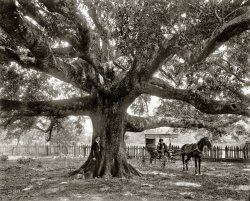
- Toulouse Street: 1937
- New Orleans circa 1937. "813-815 Toulouse Street." Watch out for the neighbors. ... allowed for many years.
The Eternal City of the US New Orleans looks pretty much the same now as it does in all these images on ... apart in a few years.
(The Gallery, F.B. Johnston, New Orleans) ... Posted by Dave - 08/14/2012 - 3:39pm -
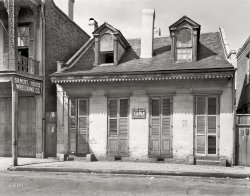
- The Shoe Line: 1943
- March 1943. "New Orleans, Louisiana. Line at rationing board." Medium format negative by ... being washed up every day.
(The Gallery, John Vachon, New Orleans, WW2) ... Posted by Dave - 09/13/2011 - 7:23pm -
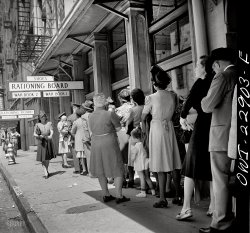
- Banana Boat: 1903
- Circa 1903. "Unloading bananas at New Orleans, Louisiana." An alternate view of this scene . 8x10 inch glass ... the relatively few African-Americans unloading fruit. The New Orleans water front was controlled by a number of unions, mostly segregated ... Posted by Dave - 07/19/2012 - 4:39pm -
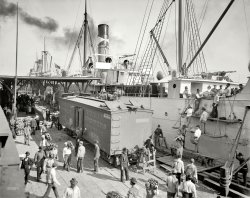
- Gingerbread House: 1936
- ...
And the Living is Easy Summer is still oppressive in New Orleans but before air conditioning the families of the rich would vacate ... Posted by Dave - 09/05/2012 - 6:05pm -
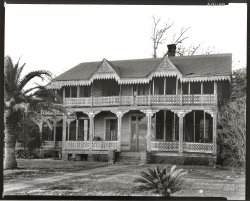
- Sweet Home Alabama: 1935
- ... SUNNY SOUTH MINSTRELS
"Featuring the Famous New Orleans Brown Skin Models. See ALVINA the Fan Dancer. Free Street Parade. ... Posted by Dave - 03/22/2009 - 10:53pm -
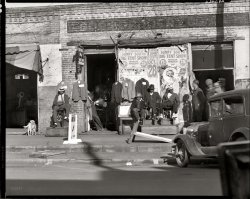
- Glass Paints Oils: 1937
- Circa 1937. "Hardware store, 906 Bourbon Street, New Orleans." Carrying a full line of protectants and preservatives, none of ... on the Island of Santo Domingo, Haiti. They married in New Orleans in 1820 and lived in the Suburb Marigny on Moreau Street between ... Posted by Dave - 09/02/2013 - 1:36pm -
![Glass Paints Oils: 1937 Circa 1937. "Hardware store, 906 Bourbon Street, New Orleans." Carrying a full line of protectants and preservatives, none of which seem to be suitable for the store itself. 8x10 acetate negative by Frances Benjamin Johnston. View full size.
Those bucketsI see little sliding doors on the sides, which would appear to cover those holes when slid down all the way. I guess it's easier to slide open a door on a heavy bucket than to tip it over and pour. Seems like there'd be a bit of leakage in these models, though.
[I suspect the holes are for ventilation and that the lining is fireproof. - Dave]
NOLA native says906 is the not the restaurant with the neon (now) but the business next door (to the right) with the red chairs, which is currently listed as a hair salon.
On the corner (going towards Canal St) are the iconic Clover Grill and across the street Cafe Lafitte in Exile which is a really famous gay bar as it claims status at the oldest continuously operating gay bar in North America.
Could be the placeView Larger Map
Back when the Quarter was a neighborhoodRather than a tourist attraction. Real stuff for real people doing real things like painting the bathroom cupboard or replacing a broken windowpane. My former home town of Carmel, CA, went from three hardware stores, five groceries, seven filling stations, and three drug stores in the '50s to zero, one, one, and one, respectively, by the '80s, but boy did we gain some galleries and boutiques!
Three bucketsI thought at first they hold items for sale, but they could have been used to strain the paint that was sold.
Holey bucketsI'm curious: what would the three buckets with holes in them hung on the door frame be used for?
Saulny's storeIn the 1880 census he is one year old, the son of 2 "mulattos", but listed as black in later census years. He's the son of a shoemaker, Louis Saulny, born 1846. Louis's father is also listed as a "mulatto", a carpenter born 1827. He died when he was 31.
Pierre SAULNY was the first Saulny in USA. He was born in Nantes, France. There is a date of birth in 1774. Some data doesn’t match so we take between 1894 to 1800 as his date of birth. He married Catherine DINET (1797-1853) free woman of color native of Pestel on the Island of Santo Domingo, Haiti. They married in New Orleans in 1820 and lived in the Suburb Marigny on Moreau Street between Elysian Fields and Frenchmen Streets since 1822 in a house situated on Esplanade Street between Conde and Royal Streets, until at least 1835. The residence of Catherine Dinet is an area that exists today and was inhabited by many free people of color as well as Creoles of European descent.
Another BarYep, that's exactly where it was, just behind Clover Grill.
I think Kozel is rightComparing the position of the window (closer to the door on the right), and the shape of the jamb, sills and lintels, I'm pretty sure the building with the neon is correct. The original photo shows a full length porch on top which is now separate balconies, but the side of the building still has porches which may indicate the front had the same ones.
Or, it could just be 907 across the street, which still has the upper porch in the right place.
[Below, 907-909 Bourbon Street. - Dave]
John McCrady School of Fine ArtsI went to art school in that white building that kozel posted. I believe I remember Mrs. McCrady saying that it was a hardware store before it was the school. But that was over 30 years ago and memories fade and Mrs Mac died long ago.
Three BucketsMy father would take me duck hunting in the 50's and we used one in our duck blind to stay warm.The small door would let more air into the fire. Worked really good when you were freezing.
(The Gallery, F.B. Johnston, New Orleans, Stores & Markets)](https://www.shorpy.com/files/images/SHORPY_01208a.thumbnail.jpg)
- Cotton on the Levee: 1903
- New Orleans circa 1903. "Mule teams and the levee." 8x10 inch dry plate glass ... traveled north The Illinois Central train traveled from New Orleans all the way north to Chicago. This is the route all blues artists ... the distance to the right.
(The Gallery, DPC, Horses, New Orleans, Railroads) ... Posted by Dave - 08/09/2012 - 2:43pm -
![Cotton on the Levee: 1903 New Orleans circa 1903. "Mule teams and the levee." 8x10 inch dry plate glass negative, Detroit Publishing Company. View full size.
Behemoth ShipSecond time this ship has shown up on Shorpy and I still can't place her. She is a massive ship for her time, and much different from the Great Lakes freighters we see here frequently.
[It's the SS Proteus. - Dave]
CapturedA "Porgy and Bess" moment; you get the feeling that any moment great music will erupt. Or not.
Jax BreweryThat looks like the Jax (Jackson) Brewery behind the IC freight car. If so, we are facing upriver. The Jax brewery was converted to shops and restaurants many years ago. It's situated on Decatur street across from Jackson square (Plaza de Armes in Spanish times).
A Short 38 YearsThe Civil war had ended only 38 years before. Some of the people in this picture were probably born into slavery.
FlotsamI'd love to know the story about the stuff floating in the water at the left edge.
SS ProteusThinking of that ship got me poking around to read of it's sinking; found here
http://www.divehatteras.com/proteus.html
The train that traveled northThe Illinois Central train traveled from New Orleans all the way north to Chicago. This is the route all blues artists and African Americans took to leave the south in droves to better lives up north,where there were jobs in countless factories,and better pay than picking cotton.
Jackson BreweryYes, that is indeed the Jackson Brewery, and we are looking uptown toward Canal St. As someone commented on the other picture like this, you can also see St. Patrick's Church steeple off in the distance to the right.
(The Gallery, DPC, Horses, New Orleans, Railroads)](https://www.shorpy.com/files/images/SHORPY_4a17029a.thumbnail.jpg)
- Milk Mare: 1910
- New Orleans circa 1910. "A typical milk cart." At the Shaving Parlor. 8x10 inch ... this hawker of cow's milk and Havana cigars has a proper New Orleans Cart License (N.O.C.L.) plate. A good shave and a good Cuban cigar ... levee failure.) Adam Schoendorf owned Hunter's Dairy in New Orleans, located at the corner of Havana and Ne Plus Ultra streets. Ne Plus ... Posted by Dave - 08/14/2012 - 3:45pm -
![Milk Mare: 1910 New Orleans circa 1910. "A typical milk cart." At the Shaving Parlor. 8x10 inch dry plate glass negative, Detroit Publishing Company. View full size.
Horse v. truckWhile looking at the harness one needs to put on the horse it is easy to see or imagine why people went to cars and motors.
Ne plus ultraThe Latin self-compliment written onto the wagon is amusing. I don't imagine many milk cartons carry such erudite phrases these days (and the glitzy harness the horse is wearing shows some real panache too).
[Ne Plus Ultra was a cigar street (see above). - Dave]
Properly RegisteredI'm glad to see that this hawker of cow's milk and Havana cigars has a proper New Orleans Cart License (N.O.C.L.) plate. A good shave and a good Cuban cigar are hard to come by in some parts. Milk, not so much.
New To MeI never realized they delivered milk without containers. Did the tank have some way of keeping the milk cool? It doesn't look that large.
The tank has an external float gauge. Better than dipping a stick into the product I guess.
The Ne Plus Ultra of dairy transportationBut, those milk pitchers might be a little too close to the hind end of the mare for me. Does "Havana" and "Ne Plus Ultra" on the side of the wagon indicate that cigars are also sold by the same driver?
This is 1910So no, the milk isn't refrigerated, except perhaps at the milk house where this cart driver picks up his can-full every morning.
I used to live where fresh milk could be had every day, and it didn't go bad nearly as fast as the milk does when i buy it at the store in a carton. The farmer we got ours from put aside some milk from his main herd in his walk in cooler in a clean sealed milk can. There it sat for 24 hours, before it was sold. Well, not really sold, but bartered for salmon we would catch from time to time.
It was an excellent arrangement, nobody got sick, he had fresh salmon regularly and we had the best tasting highest quality whole and natural milk I've ever tasted.
[Large milk cans could indeed be refrigerated. Patents for ice-cooled milk cans go back at least to the 1880s. - Dave]
You may think me too modernbut I like my milk pasteurized, homogenized, ice cold and bought in nice sanitary plastic jugs, thank you very much.
ContainersI think one can barely see the tops of some milk bottles below the drivers seat -- were they optional? Did the driver fill them on the spot?
I ApproveThe Bull City Boy is all aglow at seeing the Bull Durham (Cigar) ads on the window of the Shaving Parlor's neighbor.
Family connectionThis was a milk cart that belonged to my great-great-grandfather, Adam Schoendorf. I was delighted to see this, as I had only seen a few photos of it from the back, taken by his daughter Marie. (Those photos were probably lost after Katrina and the levee failure.) Adam Schoendorf owned Hunter's Dairy in New Orleans, located at the corner of Havana and Ne Plus Ultra streets. Ne Plus Ultra is now Lafreniere Street.
A more well-known photo of a different, larger Schoendorf vehicle can be seen here. This wagon is harnessed to a horse named Billy - "the ugliest horse my papa owed, but the smartest" according to Aunt Marie. Billy's harness features medallions with the initials "A.S." The original is in the Library of Congress, and appears in many books about New Orleans.
KV, Adam was not complimenting himself but he could have - he spoke English, German, French, Spanish, and a local patois.
(The Gallery, DPC, Horses, New Orleans)](https://www.shorpy.com/files/images/4a19877a.thumbnail.jpg)
- Bon Temps: 1900
- ... Feb. 27, 1900. "Mardi Gras procession on Canal Street, New Orleans." 8x10 inch dry plate glass negative, Detroit Publishing Company. ... has been revived in recent years.
(The Gallery, DPC, New Orleans) ... Posted by Dave - 02/12/2013 - 3:37pm -
![Bon Temps: 1900 Feb. 27, 1900. "Mardi Gras procession on Canal Street, New Orleans." 8x10 inch dry plate glass negative, Detroit Publishing Company. View full size.
Fleet's InOr at least the battleship Texas is in port. At least two and possibly three of the streetcars are carrying signs that this car goes to the USS Texas (or something similar). Note the two rows of sailors with their rifles in the "present arms" position.
This Texas was the 1892 pre-Dreadnought ship which was the first American battleship commissioned. Known as "Old Hoodoo" thanks to a number of incidents early in her career she mounted two 12" guns and six 6" guns in casmates. She was part of the Flying Squadron during the Spanish-American War and was at the Battle of Santiago. She was renamed San Marcos in February 1911 to free the name up for the Dreadnought USS Texas. Her life under this name was short as she was sunk in shallow water as a target in March 1911. The wreckage remained in place until 1959 when it was deemed a hazard to navigation.
Bleacher seating...yikesWhen did they stop allowing those monstrosities to be placed on those rickety N.O. building canopies? They look steep and dangerous just to climb up. Wonder how many people fell off sober alone?
Kingly KreweThis looks to be the Krewe of Rex.
Road HazardOne marched with care in the days of horse-drawn floats.
The Great CompromiserThe big statue among the streetcars is the Henry Clay, dedicated in 1860. In 1901, about a year after this photo was taken, it was moved to Lafayette Square, where it remains to this day.
Sister BertrilleFlying nun, lower left. Actually, the hat is sort of a poke bonnet masquerading as a wimple. Very cool.
A seeming preponderance of menAny idea why there are so few women watching the parade? I count about a half-dozen along the parade route.
The answerSo *that* is how great-great-grandma collected all those beads.
A new Shorpy recordDozens and dozens of streetcars and maybe hundreds in this picture. I don't remember seeing this many streetcars in one pic at Shorpy unless there was another one shown of this same event.
[I wonder if any were named Desire. - Dave]
Another PhotographerPerched on a rickety-looking platform on the right.
Not Rex?I don't believe this is Rex. The float is too small, and in 1900, the king's float had large lion statues on the front. The crowd is way too small for Rex on Canal in that era, and the float is going the opposite direction from the advertised route that year (should be headed towards the lake on the lower side, this one's heading towards the river). Also, Rex in 1900 was Capt. T.J. Woodward, a Civil War navy veteran with a long white beard in 1900, not this young whippersnapper.
Lundi GrasThat probably is Rex, it is just not Mardi Gras but Lundi Gras, the day Rex arrives in the City. It isn't the formal parade, and often a substitute King was used. The ceremony has been revived in recent years.
(The Gallery, DPC, New Orleans)](https://www.shorpy.com/files/images/SHORPY_4a05069a.thumbnail.jpg)
- South Street Seaport: 1901
- ... New York to Bermuda
Miami to Nassau
New Orleans to Havana
New York to Antilla
The way war is supposed ... Posted by Dave - 07/20/2012 - 7:18pm -
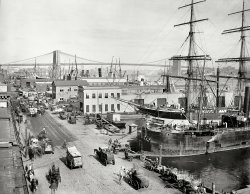
- Esplanade Ave.: 1910
- New Orleans circa 1910. "Gayarre Place monument, Esplanade Avenue." In its ... bi-centennial 1984 Louisiana World Exposition, in New Orleans , 100 years after the 1884 World Cotton Centennial :
(The Gallery, DPC, New Orleans) ... Posted by Dave - 12/10/2017 - 4:19pm -
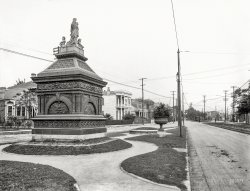
- Hung Out to Dry: 1937
- New Orleans circa 1937. "Courtyard, 620-621 Gov. Nicholls Street." Potted ... holes in those undershorts attest to the absolute power of New Orleans cuisine.
In the days before building codes a lucky horseshoe ... I saw about 35 years ago.
(The Gallery, F.B. Johnston, New Orleans) ... Posted by Dave - 12/05/2014 - 3:59pm -
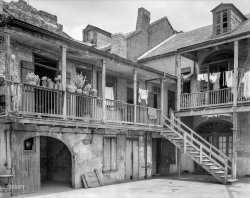
- Joe Leiter: 1912
- ... his son was killed in a hunting accident in 1921.
NEW ORLEANS, Jan. 11, 1921. -- Joseph Leiter Jr., 10-year-old son of Joseph ... Posted by Dave - 08/27/2012 - 5:06pm -
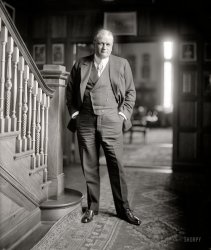
- Through the Looking-Glass
- ... of the mirror. - Dave]
In Season At least here in New Orleans, such fabric covers for the downrods of metal light fixtures used ... Posted by D_Chadwick - 01/12/2009 - 5:40pm -
![Through the Looking-Glass Self-portrait circa 1910. The only thing out of focus is the photographer. Does anyone know what kind of camera he's using? Scanned from the original 5x4 inch glass negative. View full size.
Shocking.The arm of that chair is scandalously unembellished.
Not sure about the camera...... but that shutter is a "double-dashpot," considered to be a high-quality unit. There were several manufacturers including Kodak and Bausch & Lomb.
Click.Kodak Folding or Promette c. 1907 with a ball-bearing shutter.
What's With the Chandelier?I didn't know people upholstered their ceiling fixtures! What's up with that? Look at how crisp the doily is - and how sharp and new the wallpaper is! I'll presume that all the decorations are his wife's. These days, just about the only "self-portraits" around are of the nude/porno-ish variety. Just like this gentleman, the new guys (and gals) are holding their little black shutter-thing between their fingers, too. Some things never change, do they?
FocusIs he out of focus? Or is it a long exposure, and he's blurred because he moved? I suspect the latter.
[Either way, he's out of focus. - Dave]
Profile PicThe first MySpace photo!
Fly Speck Shield?The fabric wrapping on the chain and arms of the chandelier looks very ad-hoc, not very well fitted and coarsely stitched. This could be a holdover from the 19th Century practice of covering gilded metal with gauze or other fabric during the summer months to prevent fly specks (an 1876 housekeeping manual I found suggests painting gilded picture frames with onion juice for the same reason). The mass-produced oak pier mirror and its gewgaws mostly date from the 1880s, while the bit of the chair seen at left is more like 1895-1905. The photographer also appears in the framed engagement or wedding photo on the wall behind him. He hasn't aged much from that portrait to the mirror image shot.
The fixtureChildren, the light fixture is wrapped in muslin, from the chain down to the shades, because it's new, or the household is redecorating. Once everything was up and you were done painting and papering, you'd unwind the entire business. Nowadays it would of course be plastic.
-- Great-Great Grandma
The CameraThe knob at the top of the lens standard (below left in the photo, above and right in real life) suggests it is some version of a Korona Cycle Camera by Gundlach of Rochester, N.Y.
WallpaperGorgeous! I love it. Some things should come back in style.
Christmastime?I wonder if this was around Christmas, since there appears to be a reindeer in snow in the glass bell.
"Double Exposure!"What an interesting composition - the picture on the wall directly behind the man's head seems to be another picture of the same man! It's like he's looking in the mirror at his older self, and showing us what he sees.
Thinks she can have it all, does she?Well, the last laugh's on her. I'll take a photographic catalogue of everything in this house, by gum, when that judge says to split things right down the middle you can bet it'll be done with surgical precision! She gets the damned rococo wallpaper, I get the reindeer sno-globe!
Fern from nowhereWhere is that fern sprouting from ? It appears to be right on the buffet/sideboard/dresser but I don't see a vase and there is nothing in the glass globes hanging from the cherub thing. It is bugging me now.
[If the fern were on that table, the fronds wouldn't stop at the edge of the mirror. - Dave]
In SeasonAt least here in New Orleans, such fabric covers for the downrods of metal light fixtures used to be fairly common. (I imagine there used to be a term for such devices but I don't know it. Lighting fixture stocking?)
In the days before air-conditioning, the fashion was to redecorate the house twice a year for winter and summer style among the well-to-do and middle class who wished to emulate them. Different summer and winter carpets on the floor, etc. Much was clearly intended to lessen the southern summer heat, but some details seem obscure now. In summer you'd dress up the lighting poles and other shiny metal objects with fabric. Someone told me it was to keep away the bugs which would be attracted by the shine. For the majority of people who had bass fixtures (as opposed to the very rich who'd have them gilded) it would have the practical advantage of allowing you not to have to polish them for the whole summer.
(ShorpyBlog, Member Gallery, Portraits)](https://www.shorpy.com/files/images/Self-Portrait-D_C.thumbnail.jpg)























